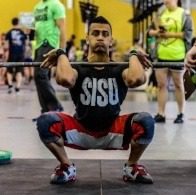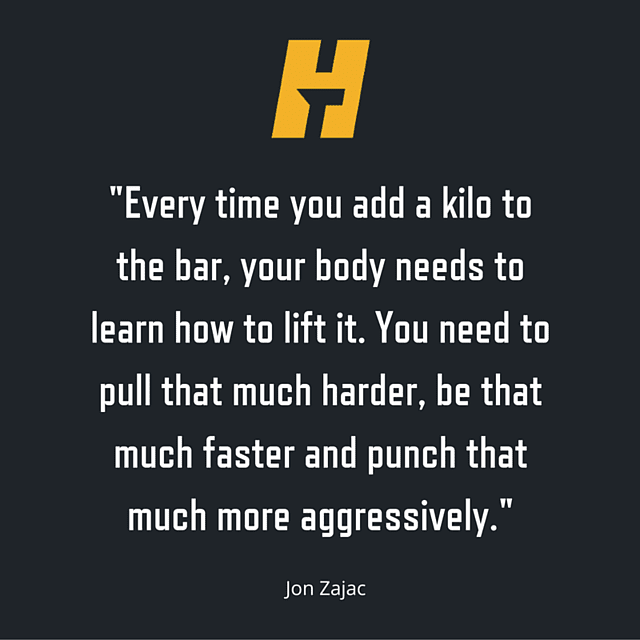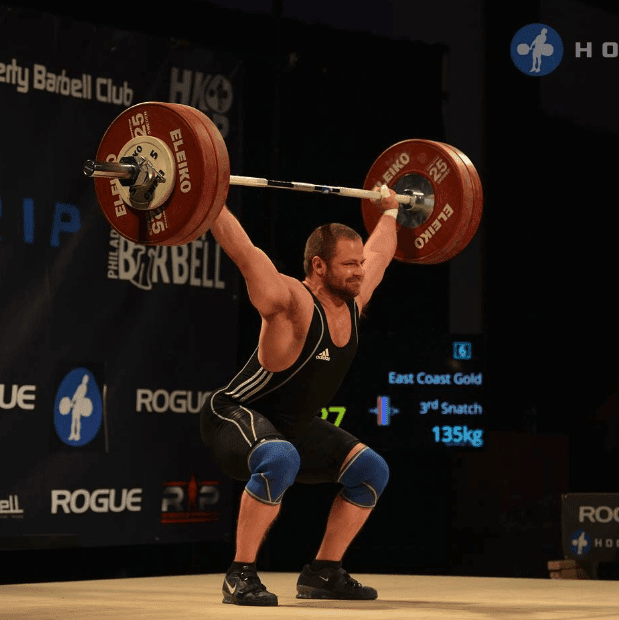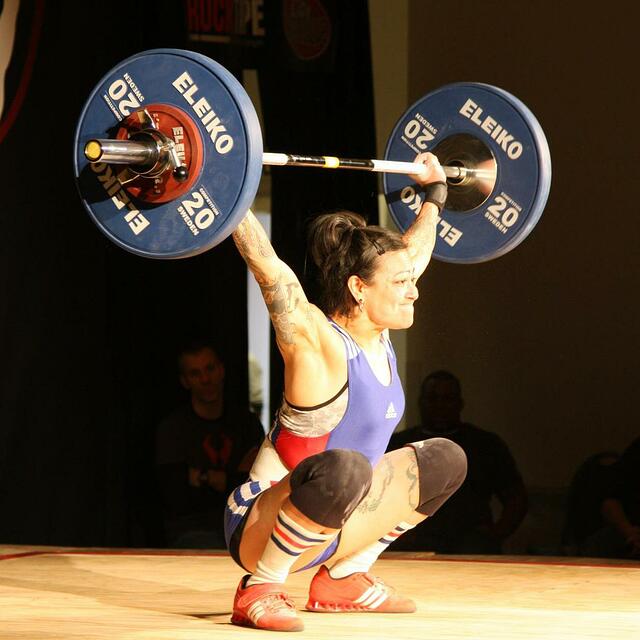The Great Max Out Debate: What Olympic Weightlifting Coaches Should Know About Testing Their Athletes Top End
Strength & ConditioningABOUT THE AUTHOR

Misbah Haque
Misbah Haque is the owner of AirborneMind.com. The heart of his blog is centered around strengthening the bridge between Olympic Weightlifting and CrossFit. He strives to make the barbell more accessible to newcomers and CrossFitters looking to get stronger. Misbah coaches both disciplines while competing as a 62kg lifter. He is a USAW-SPC, CF-L1 Trainer, and is studying Kinesiology.
What follows is an interview with Jon Zajac in which he covers everything you need to know about testing your athletes top end, the ever elusive one rep max.
Jon is the owner of Lancaster Fitness & Performance where he works closely with a team of weightlifters at Lancaster Barbell Club along with tons of remote athletes.
// What’s the difference between finding a true 1RM and working to a heavy single?
Jon Zajac: Maxing out for a 1RM is about really getting mentally prepared, for that rep and session. You know a few days ahead of time that you will be going for this attempt and you really think about it. You visualize this lift over and over again feeling every aspect of it.
Going to a heavy single is just that, you work up to a weight that is fairly heavy. 90% is a good gauge for this. It is a rep that doesn’t take much mental prep for, and you can hit it a few times a week at almost any point in your training cycle.
MH: I love how you emphasize the mental prep. This internal gauge definitely takes some time to develop. I remember when I first started lifting, I would go balls out every session. It’s tempting to max out sometimes, but you gotta know the objective for the day.
I’m going to link one of the most game-changing series of articles on psychology in Weightlifting in the notes.
// Why should athletes max out? When should athletes max out?
JZ: Athletes need to max out to find out how much progress they have made. Not all progress is measured in heavy singles, though they can also make improvements in their technique. Early on, athletes will make all sorts of gains from just learning how to do the lifts, and their bodies moving more efficiently.
I think an athlete needs to hit a few heavy reps a few times a week to learn how to lift heavy weights. Everytime you add a kilo to the bar, your body needs to learn how to lift it. You need to pull that much harder, be that much faster and punch that much more aggressively.

Anyone can have perfect technique at lighter weights and as this does help, you need to be able to have good technique at heavy weights. Weightlifting is all about lifting the maximum amount of weight that you can. So if you cannot lift heavy what is the point.
MH: Hahah absolutely. The feeling of the bar just changes when you get into that heavier range. You’ll think you’re moving like Kendrick Farris, and all of a sudden it’s like you forgot how to Snatch. Timing, focus, and all these factors have to be sharper than ever.
Something really useful I heard recently is that the positions don’t change. When you’re lifting lighter weights, hit your positions. When you’re tired and hitting submaximal or maximal weights — hit those positions.
What does change is the effort required.
The Chinese max out every Friday, and there’s this awesome quote:
“If you go to the mountain often enough, you will meet the tiger.” – Chinese Proverb
// Is there a difference between competition 1RMs and training 1RMs as far as effort?
JZ: There is a huge difference between competition PRs and training PRs. In training, it is really hard to get yourself in that zone mentally, that you can in a competition. At the competition, you are normally peaked for it as well. Your body feels good and your mind is not exhausted, so you can put a lot of mental energy into the lifts. Newer lifters will normally have better training lifts since they do not have the competition experience and may still get stage fright.
MH: How about for the athlete who doesn’t compete in competition lifts? Should they be focusing solely on training PRs or is there some other way for them to simulate competition?
JZ: If they do not do sanctioned meets they can still pick a date and train to max out that specific day, and do a peak for it. They can go into it like it is a competition and only have 3 attempts at that lift. If they do not want to do this, they can just go off of training PRs. For them the competition PR is not important, since it is not their sport of focus.
// Is there a difference between maxing out on Olympic lifts vs Power lifts such as Squats and Deads?

JZ: The Olympic lifts are much more taxing on the central nervous system than they are on the muscles since it is only a concentric loading of the muscles. On the Power lifts, it is both eccentric and concentric loading while also being a lot more time under tension. All of those factors make hitting a max in these much more taxing. The more often you do go heavy, the more your body will adjust to the intensity, and be able to recover faster from it.
I think you should go to a heavy single in the Power lifts at least once a week to keep your central nervous system adapted to the heavy weight. Right after a competition you can take a few weeks to rebuild and not hit a heavy lift, but as you get closer to a competition I think it is crucial to feel that heavy weight on your body.
MH: I totally agree. I remember when I used to come to your classes on Sunday mornings. I asked you if it was bad to Snatch heavy or go heavy in general on back to back days. You told me that you did the Snatch & CJ/Cl every day, and sometimes twice.
I was like WOW. That’s what I wanted to do. Not necessarily run myself into the ground everyday. But if I was feeling good, I didn’t want to do all my sets at 70%. If cylinders are firing, I want to push it.
// Can maxing out everyday lead to injuries?
JZ: If it is just a heavy single and it is early on in an athlete’s career, no I do not think they can. Since it’s just not very heavy of weights. As they get into their careers, I think they can definitely injure themselves since it is more taxing.
Pushing a heavy squat every day can lead to many different types of injuries. Many people think this “squat everyday” means go to a max every day. And these people will end up having quad tendonitis or tearing a muscle eventually. They do not have time to recover from the session and let their muscles recover.
MH: It comes back to the internal regulator I think. Most beginners haven’t developed that “Sixth Sense” yet. Heavy singles are really that perceived effort for that given day and that given moment. Beginners get frustrated sometimes when they aren’t near their all time 1RM every single session.
I personally believe that if you do too much of one thing without addressing the little gaps, you will get injured. Squatting everyday is something I tested with one of my athletes. And although she crushed her squat PRs in 6 weeks by a total of 30lb, the imbalances become more apparent. We had to do a ton of mobility and stability work.
Same thing goes for CrossFit, running, or weightlifting. At some point, you will need accessory work, or you will get injured. That’s why I like the finishers you make us do.
// How often should coaches test 1RMs?
JZ: I think early on in an athlete’s career they can test their 1RM more often. They are not lifting very heavy weights so it is not very taxing on their body. They can do a real 1RM at least once a week. As you get further into their career, you go for 1RMs less and less. It is a combination of getting older and the weights being heavier.
Me personally, I go for a real 1RM only when I do competitions which is normally 4-5 times a year now. If I feel good in training on a day I am going heavy, I will definitely push it. And if a PR happens, great! If I get to 95%, that’s still a pretty good day.
MH: I really like that because it just gives you more confidence. It forces you to learn how to commit to the lift.
// So the golden question. Give us your method to gains. How do you max out?
JZ: I go to a heavy single in each lift at least twice a week. Sometimes three. I only max out when I am in a competition and that is after I do a peak for the meet.
Peaking for a meet is mainly:
- Dropping volume back and keeping the intensity up
- Then dropping the intensity right before the meet
- And then competing
Peaking is very individualized. So what works for some may not work for others. It just takes trying some different things leading up to a meet to find out what you like and what really works.

// What is your process for leading up to a meet?
JZ: My process is building as much volume on my lifters as I can between meets while keeping the intensity as high as I can – without causing them injuries. If I start to see them all breaking down too early, we will back off the volume, and then hang out there. Then build back up.
In the program I only change 1-2 movements a week to really see how they are affecting the lifters. I think many people cannot handle doing this since they want so much variety. But with doing that, they never really know what is actually helping or hurting their progress.
New lifters especially make so many gains in the beginning that when they get to their first plateau they do not know how to break through a plateau since they change their programs so much. They have no idea what will actually work and make them better.
MH: This is so true. Especially, if we’re coming from a CrossFit background where “constantly varied” is gospel.
I’ve been in this boat when I first started working with athletes. I almost felt like I wasn’t being creative enough or that they would get bored if we kept doing the same exact thing. But the truth is that you have to narrow your focus down to a key group of lifts that you have a very good reason for using, and commit to it.
I love that structure now. And I try to explain that as best as I can to the CrossFitters I work with. Save your variety for the metcons, structure your lifting and accessory work.
// How many max attempts can you take before it’s too much?
JZ: I typically tell my lifters to only take 3 attempts at a lift. If it is a strength issue, I only let them take one. But if it is a small technique thing, I won’t let them or make them take many attempts at it. They need to learn how to make adjustments from lift to lift at the same weight just as they would on the platform.
MH: Absolutely. Sometimes prescribing a certain number of allowed misses is necessary if you have athletes who just go balls out every session, and don’t understand why they aren’t hitting certain lifts.
Missing is valuable though. It teaches you a lot.
// What is a daily max?
JZ: A daily max is the same as a heavy single really, just something you can hit without needing to put a lot of mental energy into it.
MH: And how about daily minimums? These are my favorite.
JZ: I like to use daily minimums for my athletes and say you should be able to hit this lift unless you are super exhausted and life is really getting in the way. The closer their daily minimum gets to their PR, the better chance they have of hitting a new PR soon.
MH: This was the game changer for me when I first started hitting 165 consistently out of nowhere. You said to focus on raising the daily minimum instead of the all time PRS, which is daunting for newer lifters. A better way to gauge progress is pushing and raising that minimum. It’s a clearly defined goal and completely attainable. This was one of my favorite concepts.
Be sure to check out the resources below. There are articles, videos, and books I’ve found very useful, and anything we’ve mentioned here during the interview will be listed.
Thanks for reading! Leave a comment below on your thoughts, we’d love to hear from you.
Resources:
- Auto-Regulation Equates To Success
- Training Guidelines: Autoregulation is the single best training principle for high results
- Squat Everyday Cures All Ailments
- Study: Reliability of the One-Repetition Maximum Test Based on Muscle Group and Gender
- Max Out On Squats Every Day
- Intensity: Going By Feel vs. Strict Percentages
- Move Faster: How To Improve Speed And Explosiveness In The Snatch
- Max Out Lifting Tips
- Why CrossFit athletes should try a Weightlifting meet just ONCE even if you think you can’t
Sports Psychology:
- Psychology in the Weightlifting Arena (Part 1 of a Series)
- Psychology in the Weightlifting Arena, Part 2 – Fighting External Noise
- Psychology in the Weightlifting Arena, Part 3 – Controlling Internal Noise
- Psychology in the Weightlifting Arena, Part 4 – Getting Centered
- Psychology in the Weightlifting Arena, Part 5 – Charging Up
- Psychology in the Weightlifting Arena, Part 6 – Discharging
- Psychology in the Weightlifting Arena, Part 7 – The Lifter’s Trance
- How To Manage The Voice Between Your Ears – Less Stress – Less Anxiety – More Focus – More Happiness
- Relentless by Tim Grover
- Mindful Athlete: Secrets To Pure Performance by George Mumford
- Mind Gym: An athlete’s guide to inner excellence
Are you a better coach after reading this?
More coaches and athletes than ever are reading the TrainHeroic blog, and it’s our mission to support them with useful training & coaching content. If you found this article useful, please take a moment to share it on social media, engage with the author, and link to this article on your own blog or any forums you post on.
Be Your Best,
TrainHeroic Content Team
HEROIC SOCIAL
HEROIC SOCIAL
TRAINING LAB
Access the latest articles, reviews, and case studies from the top strength and conditioning minds in the TH Training Lab

